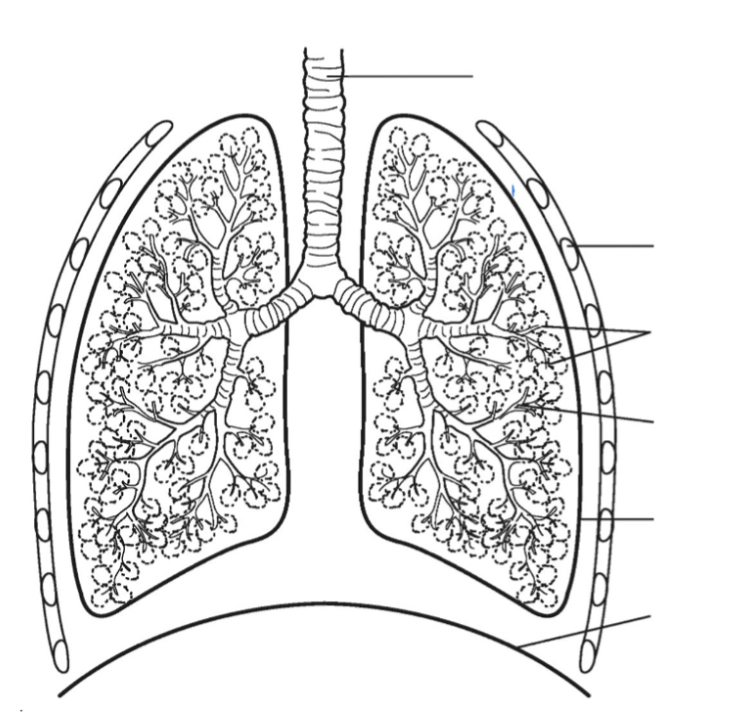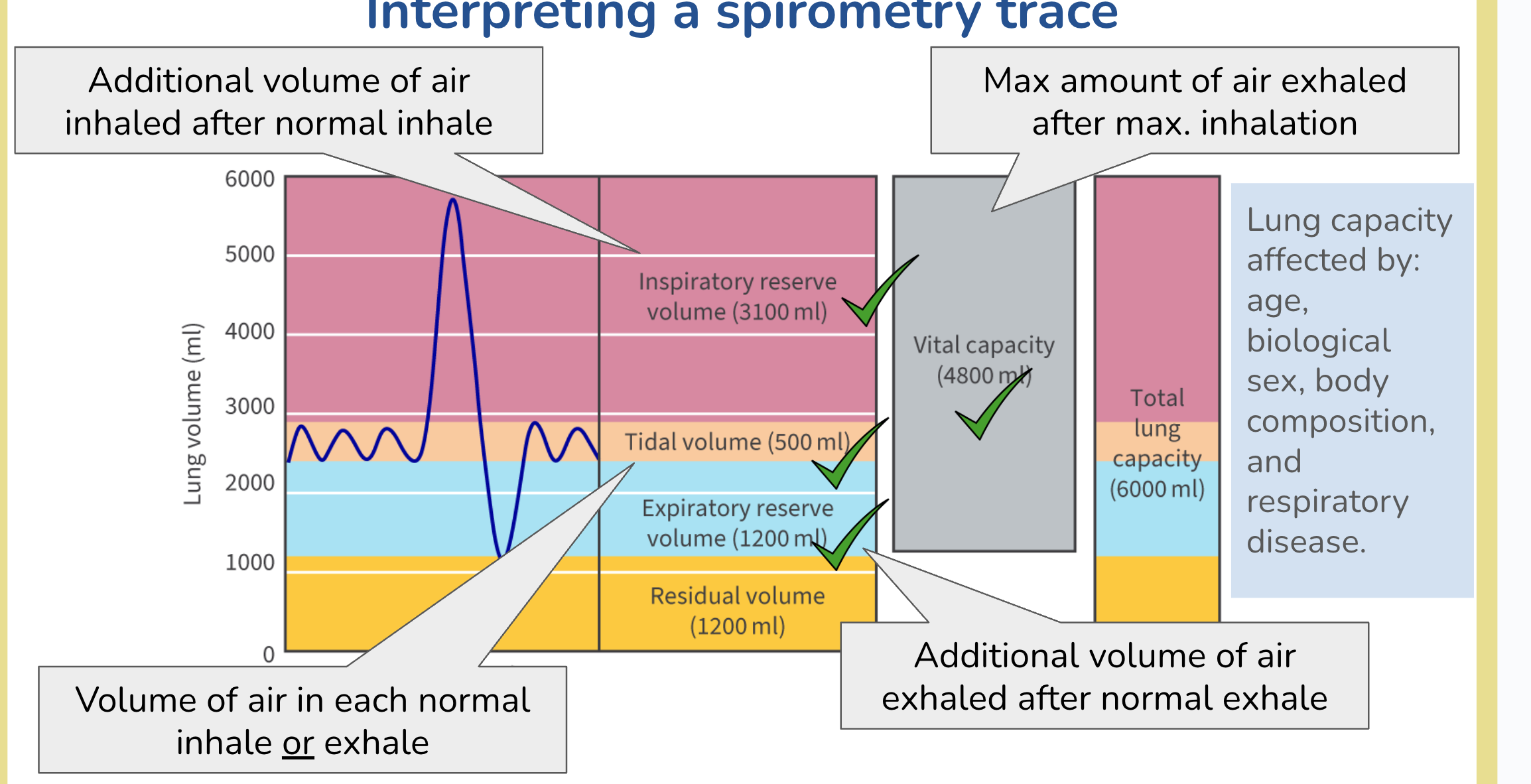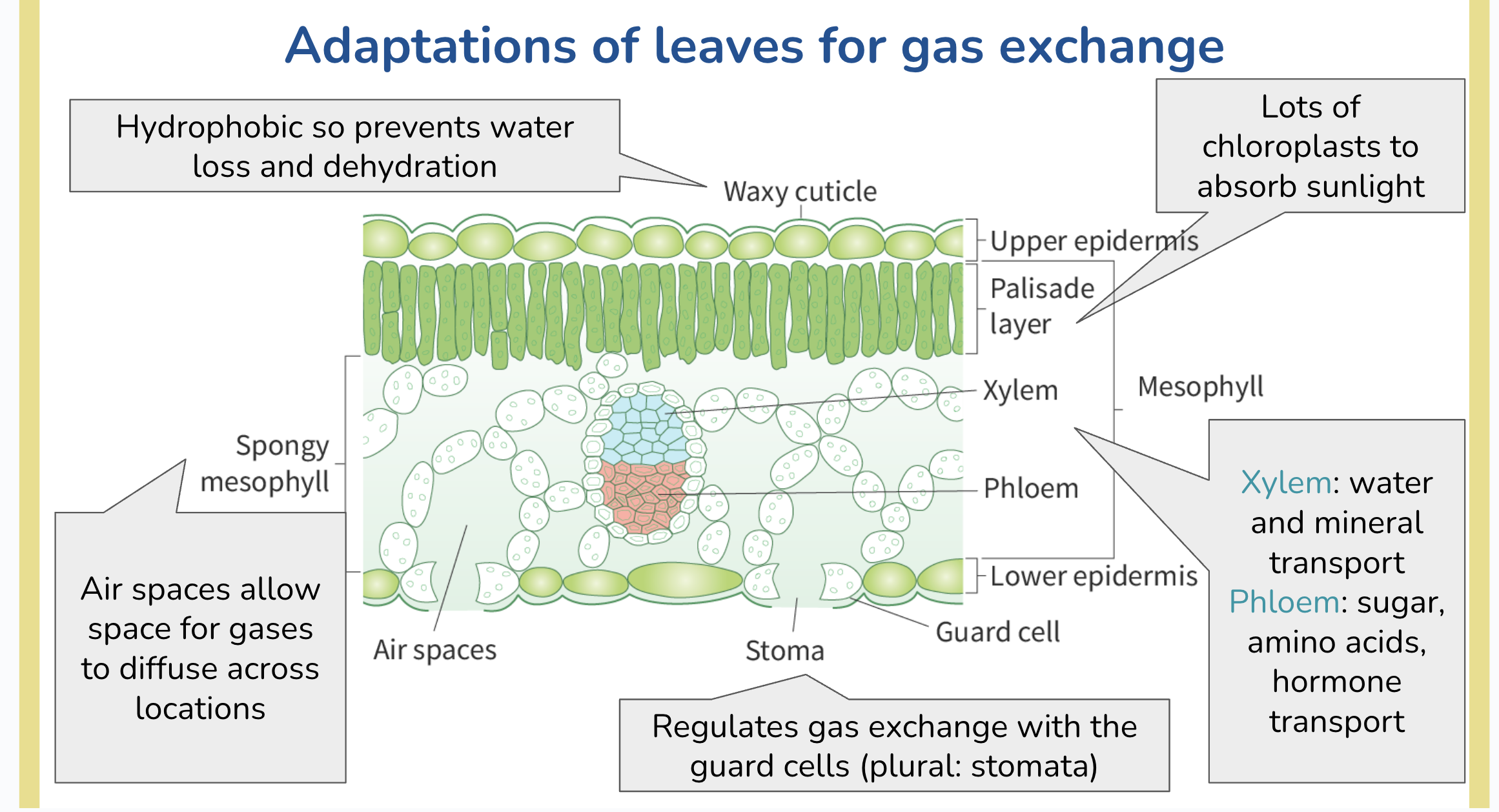B3.1 gas exchange
1/27
There's no tags or description
Looks like no tags are added yet.
Name | Mastery | Learn | Test | Matching | Spaced |
|---|
No study sessions yet.
28 Terms
gas exchange function
obtain gases for metabolism
release waste products
gas exchange occurs
diffusion - gases travel from high to low concentration to reach diffusion
structure to facilitate gas exchange (4)
large SA:V (branches+foldings)
permeability of O2 and CO2
thin tissue layer minimise diffusion distance
moist layer for gases to dissolve
how is concentration gradient maintained (3)
Dense capillary network around gas exchange surfaces
Continuous blood flow
Ventilation
With air for lungs
With water for gills

Lungs
trachea
bronchus
bronchiole
alveli
lungs
ribs
intercostal muscle
diaphragm
definition for ventilation + gas exchange + cellular respiration
Ventilation : exchange of air between atmosphere and lungs - breathing
Gas exchange : exchange of O2 and CO2 between alveoli and bloodstream - passive diffusion
Cellular Respiration : release of ATP from organic molecules
exchange on ventilation rate
increase rate exercise > increase cellular respiration > increases uptake of oxygen > increase ATP - breath in faster
By product of cellular respiration increases: Co2 > blood gets acidified > proteins like RBC denatures > dont carry oxygen > dies.
To avoid Co2 accumulation - breath out faster > ventilation rate faster
respiratory system (5)
air travels from nose&mouth - pharynx - trachea
air divides into two bronchi
right : 2 lobes, left : 3 lobes
bronchi - many bronchiole ( increases SA)
bronchiole - airsacs: alveoli ( gas exchange w bloodstream occurs)
structure of alveolus
thin epithelial layer ( one cell thick ) > minimuze diffusion distances
surrounded by rich capillaries layer > increase capacity for ge with blood
spherical in shape > maximize SA for ge
internal surface - covered with surfactant > dissolved gas better able to diffuse in bloodstream + reduce surface tention
where is pneumocytes
(alveolar cells) - line the alveoli , comprise the majority of inner surface of lungs
what is alveoli made out of
type 1 + type 2 pneumocytes
type 2 pneumocytes
secrete alveolar fluid → contain surfactant
how surfactant works
both alveoli have equal surface tension
left one - smaller radius - higher pressure - hard to inflate, more likely to collapse
with surfactant: less surface tension, able to have same pressure - wont collapse
adaptations for lungs(4)
surfactant - decrease pressure
short diameter of bronchiole - slow air flow increases efficiency
many alveoli attached at the end - increase SA for gas exchange
extensive capillaries around alveoli - short diffusion distance
ventilation in antagonistic muscle
exhalation
external intercostal muscle - contracts → ribcage move out and up
diaphagram - contracts → move down and flattens
volume increase , pressure decrease → in thorax
air flows into the lungs - reaches atmospheric pressure
inhalation
internal intercostal muscle - contracts → ribcage move in and down
abdominal - contracts → pushes diaphragm into dome shape
volume decrease , pressure increase → in thorax
air flows out the lungs - reaches atmospheric pressure
measure lung volume
spirometry
spirometry trace

gas exchange in leaf
stomata
guard cells control opening and closing of stomata
adaptations of leaf

waxy cuticle
palisade layer
spongy mesophyill
xylem&pholem
stoma & guard cells
transpiration
water lost by stomata
Water vapour is lost via the stomata
Diffuses down its concentration gradient into the atmosphere → creating negative pressure in the xylem
Creates tension that further draws water up the xylem from the roots to the leaves.
Transpiration facilitates:
Temperature regulation
Absorption of water and minerals from soil
factors affecting transpiraton
increase transpiration
wind: ^water concentration gradient
temperature : ^ saturation point of air
light : ^ photosynthesis
decrease transpiration
humidity : decrease water concentration gradient
hemoglobin (location, function , structure)
Location: RBC
Function : transport O2 to respiring tissue, transport byproduct Co2 to lungs
Structure : quaternary , conjucated protein - 4 polypetide with heme group
hemoglobin and oxygen
coorporative binding
structure changes - affinity for oxygen ^
why gamma polypetides have a greater affinity to O2 than beta ones
more efficient delivery of O2 from placenta to fetus
Co2 binds xx to hemoglobin
allosterically
change the shape - less affinity for O2
O2 unloaded to areas with low PO2 but high PCO2
how does Bohr Shift illustrates when there is ^ in Co2
^ in CO2 - ^ in carbonic acid → ^ pH
bind allosterically → structure changes - lower affinity for O2
O2 curve shift → release for respiring tissue